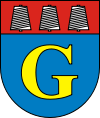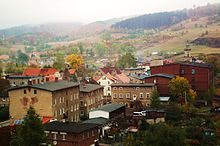Głuszyca
| Głuszyca | ||
|---|---|---|

|
|
|
| Basic data | ||
| State : | Poland | |
| Voivodeship : | Lower Silesia | |
| Powiat : | Wałbrzych | |
| Geographic location : | 50 ° 41 ′ N , 16 ° 22 ′ E | |
| Residents : | 6361 (Jun. 30, 2019) |
|
| Postal code : | 58-340 | |
| Telephone code : | (+48) 74 | |
| License plate : | DBA | |
| Economy and Transport | ||
| Street : | DW381 Wałbrzych - Nowa Ruda | |
| Rail route : | Wałbrzych – Kłodzko | |
| Next international airport : | Wroclaw | |
| Gmina | ||
| Gminatype: | Urban and rural municipality | |
| Gmina structure: | 5 school offices | |
| Surface: | 61.92 km² | |
| Residents: | 8631 (Jun. 30, 2019) |
|
| Population density : | 139 inhabitants / km² | |
| Community number ( GUS ): | 0221053 | |
| Administration (as of 2015) | ||
| Mayor : | Roman Głód | |
| Address: | ul.Grunwaldzka 55 58-340 Głuszyca |
|
| Website : | www.gluszyca.pl | |
Głuszyca (German Wüstegiersdorf , until 1917 in the spelling Desert Giersdorf ) is a town in the powiat Wałbrzyski in the Lower Silesian Voivodeship in Poland . It is the seat of the urban and rural community of the same name .
geography
Głuszyca is located in the Waldenburger Bergland , on Voivodship Road 381, which leads from Wałbrzych ( Waldenburg ) to Kłodzko (Glatz) . Neighboring towns are Jedlinka ( Tannhausen ) and Olszyniec ( Erlenbusch ) in the north, Jawornik ( Oberdorf-Jauernig ), Dolki ( Niedergrund ) and Walim ( Wüstewaltersdorf ) in the northeast, Grządki ( Grund ) and Rzeczka ( Dorfbach ) in the east, Sokolina ( Silesian Falkenberg ) , Sierpnice ( Rudolphswaldau ) and Kolce ( Dörnhau ) in the southeast, Nowa Głuszyca ( Neugiersdorf ) and Głuszyca Górna ( Upper Giersdorf Desert ) in the south, Łomnica (Lomnitz) and the submerged Radosno ( Freudenburg ) in the southwest and Grzmiąca ( Donnerberg ) Sophienau ) in the northwest. To the east lies the ruins of Rogowiec Castle ( Hornschloss ). South of Głuszyca Górna, the tourist border crossing Głuszyca Górna / Janovičky leads over the Heidelberg ridge to the neighboring Czech municipality of Heřmánkovice .
history
Wüstegiersdorf was first mentioned in 1305 as "Neu-Gerhardisdorf". It belonged to the Hornschloss castle district in the Duchy of Schweidnitz and together with it came to the Crown of Bohemia in 1368 . Since 1509 it was owned by the noble Hochberg family on Fürstenstein . In the middle of the 16th century, she initiated the repopulation of the place destroyed in the Hussite Wars by Saxon miners. After the mining had to be stopped in 1586, the line weaving expanded.
After the First Silesian War , Wüstegiersdorf and Silesia fell to Prussia in 1742 . After the reorganization of Prussia, it belonged to the province of Silesia from 1815 and from 1816 was incorporated into the Waldenburg district, with which it remained connected until 1945. Since 1874 the rural community of Nieder Wüstegiersdorf was the seat of the district of the same name , to which the rural community of Kaltwasser also belonged. In 1917, Nieder Wüstegiersdorf was renamed "Wüstegiersdorf".
The first mechanical cotton weaving mill A. Großmann, built in 1838 and transferred to the Berlin company N. Reichenheim & Sohn in 1845, was of economic importance. Further jobs were created in 1862 in neighboring Tannhausen with the establishment of the flax yarn spinning mill and flax bleaching of the Websky, Hartmann & Wiesen AG company. Tablecloths, fabrics for bed linen and book cover fabrics were produced. Another important textile factory in Wüstegiersdorf was the “wool department” of Meyer Kauffmann Textilwerke AG, founded by Salomon Kauffmann (1824–1900) in Breslau . Its general director was from 1918 to 1933 Hans Schäfer (1880–1945).
In 1929 Wüstegiersdorf and a portion of Tannhausen, Blumenau and Kaltwasser were merged to form the municipality of Wüstegiersdorf. In 1939 it consisted of 6,952 inhabitants.
At the time of the Second World War , part of Wüstegiersdorf next to Dörnhau belonged to the Riese complex , a satellite camp of the Groß-Rosen concentration camp , which was set up for the Todt organization .
In 2000, in the Wüstegiersdorf ( -Tannhausen ) labor camp , predominantly Jewish prisoners were housed in a three- story factory building. This was fenced in with barbed wire and guarded by 75 men. The prisoners were primarily used to build track systems and build tunnels . The camp in Dörnhau was also set up in a former factory building in 1943. About 2000 people were also housed there. There was a central infirmary on the first floor. The prisoners were used for sewer works, tunnel construction and road construction. The Krupp AG in 1944 moved the detonator production from food to Wüstegiersdorf and employed in December 1944 224 prisoners of war, in 1029 foreign forced laborers and another 200 Hungarian and Croatian female concentration camp prisoners.
As a result of the Second World War, Wüstegiersdorf fell to Poland in 1945, like almost all of Silesia, and was renamed Głuszyca . The German population was expelled unless they had already fled . The new residents of the place were partly Polish expellees from eastern Poland . The factory building used as a labor camp during World War II was used again for the production of technical components after 1945. In 1954 Głuszyca was promoted to an urban-like settlement and in 1961 to a city. 1975-1998 Głuszyca belonged to the Wałbrzych Voivodeship ( Waldenburg ).
Community structure
The municipality of Głuszyca covers an area of 61.92 km² and consists of the following districts:
- Głuszyca
- Głuszyca Górna (Upper Wüstegiersdorf)
- Grzmiąca (Donnerau)
- Kolce (Dörnhau)
- Łomnica (Lomnica)
- Sierpnica (Rudolfswaldau)
Attractions
- The parish church of Maria Königin was built in 1809 as a Protestant church and transferred to the Catholic Church after the transition to Poland in 1945. The hall building with two-story galleries contains uniform furnishings from the beginning of the 19th century. The main architectural altar contains the figures of St. Peter and Paul. The main altar painting “Our Lady of Czestochowa” is from more recent times.
- Houses from the 18th and 19th centuries, e.g. B. “Gasthaus zur alten Brauerei” (Pod Jeleniem) from 1784.
sons and daughters of the town
- Egmont Websky (1827–1905), textile manufacturer and member of the Reichstag
- Gustav Schröer (1876–1949), writer and peasant functionary in Thuringia
- Reinhard Grätz (* 1940), engineer and politician (SPD)
- Marek Mendyk (* 1961), Catholic clergyman, Bishop of Schweidnitz
literature
- Hugo Weczerka (Hrsg.): Handbook of the historical places . Volume: Silesia (= Kröner's pocket edition . Volume 316). Kröner, Stuttgart 1977, ISBN 3-520-31601-3 , pp. 573-574.
- Dehio Handbook of Art Monuments in Poland Silesia . Munich · Berlin 2005, ISBN 3-422-03109-X , pp. 316-317.
Web links
- Historical and current images and geographical location: Głuszyca
- Historical and current recordings and geographical location: Głuszyca Górna
Individual evidence
- ↑ a b population. Size and Structure by Territorial Division. As of June 30, 2019. Główny Urząd Statystyczny (GUS) (PDF files; 0.99 MiB), accessed December 24, 2019 .
- ↑ City website, Władze miasta ( Memento of the original from February 7, 2015 in the Internet Archive ) Info: The archive link has been inserted automatically and has not yet been checked. Please check the original and archive link according to the instructions and then remove this notice. , accessed February 7, 2015
- ^ Wüstegiersdorf district . territorial.de
- ^ Teresa Nentwig: Hinrich Wilhelm Kopf and his work during the "Third Reich". Addenda to a debate . In: Niedersächsisches Jahrbuch für Landesgeschichte , vol. 88 (2016), pp. 227–333, here p. 287.
- ^ Max Kreutzberger (edit.): Leo Baeck Institute, New York: Library and Archive. Catalog , Volume 1: German-speaking Jewish communities. Newspapers, magazines, yearbooks, almanacs and calendars, unpublished memoirs and memorabilia . JCB Mohr (Paul Siebeck), Tübingen 1970, pp. 427-428.
- ^ Forced labor camp for Jews Dörnhau
- ↑ The Giant Complex (PDF; 215 kB)
- ↑ The labor camps in the Riese project ( Memento from January 4, 2015 in the web archive archive.today )
- ↑ Werner Abelshauser : Armaments smiths of the nation? The Krupp concern in the Third Reich and in the post-war period 1933 to 1951. In: Lothar Gall (Hrsg.): Krupp in the 20th century. The history of the company from the First World War to the establishment of the foundation. Siedler, Berlin 2002, ISBN 3-88680-742-8 , pp. 424, 439.






